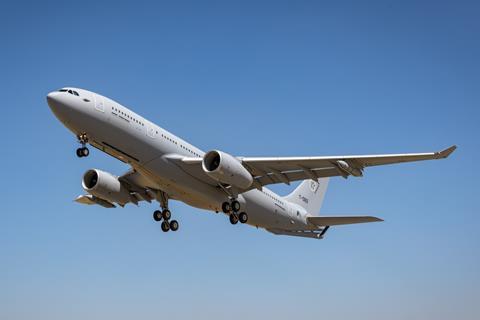Airbus Defence & Space has begun derisking studies for an A330neo-based version of its Multi-Role Tanker Transport (MRTT) which could begin arriving by the end of the decade.
Ever since the Neo’s launch in 2014 there has been speculation that the airframer would consider an updated version of the MRTT, but it has previously denied that such a move was imminent.
But as Airbus ramps up production of the A330neo, the manufacturer faces a dwindling number of production slots for the A330-200 on which the MRTT is based. As a result, its defence unit is now treating the need to switch between the two platforms with greater urgency, confirms programme chief Maria Angeles Marti.

“We are thinking about the Neo today,” she said, speaking to journalists at an event near Huelva in southern Spain.
There are only “limited units” of the legacy platform still available to MRTT buyers and “these are the ones we are prioritising in our current campaigns”, she says.
“Once those units are sold, then we will transition in a natural way to the new platform.
“That’s why we are working in parallel to derisk fully that development and to have the confidence to offer the platform after those units are sold.”
She declines to say how many slots remain for A330-200-based MRTTs, but it is thought to be only a handful of airframes.
Key differences between the legacy and Neo variants of the widebody are the latter’s Rolls-Royce Trent 7000 engines, a new and more flexible wing, and updated avionics.
Studies being carried out by Airbus Defence & Space include the feasibility of fitting pods for the hose and drogue refuelling system onto the new wing.
Marti is positive about the outcome of those evaluations.
“We have derisking activities running today and we have a high level of confidence that the risk we would take by putting the pods and [refuelling system] on to the Neo is very low.
“We believe there is no problem for that evolution to happen.”
Marti will not say on which Neo variant the updated MRTT would be based, but the A330-800 is more likely than the stretched -900 given its equivalence to the original -200. No A330-300-based MRTT has been produced.
Airbus has multiple active campaigns running for the MRTT, but has yet to start offering the Neo-based variant.
However, that may soon change: “We did not hit the market yet but we are going to start very soon,” Marti says.
She believes the better fuel economy offered by the Trent 7000 engines and improved technology on the Neo will be significant selling points for customers.
“We believe the new airplane will be better. There are no obsolescence issues and it has better avionics – the -200 comes from the 1990s.”
And, she says, new features such as the airframer’s A3R automatic air-to-air refuelling technology could also be added.
“We are even thinking about embedding A3R as part of the standard airplane,” she says.
Several recent MRTT customers – Spain and Brazil, for example – have opted to convert secondhand aircraft to the MRTT standard, but Marti warns this option will not be available forever given the dwindling feedstock available.
“The secondhand market has limited years because you need to have an airplane with certain age to be able to deliver [a tanker] to the armed forces that will last for 30 years.”
She notes that the last -200 was built in 2018, adding: “We still have a few years where the secondhand option is still available but if you wait for five years it won’t be an option any more.”


























